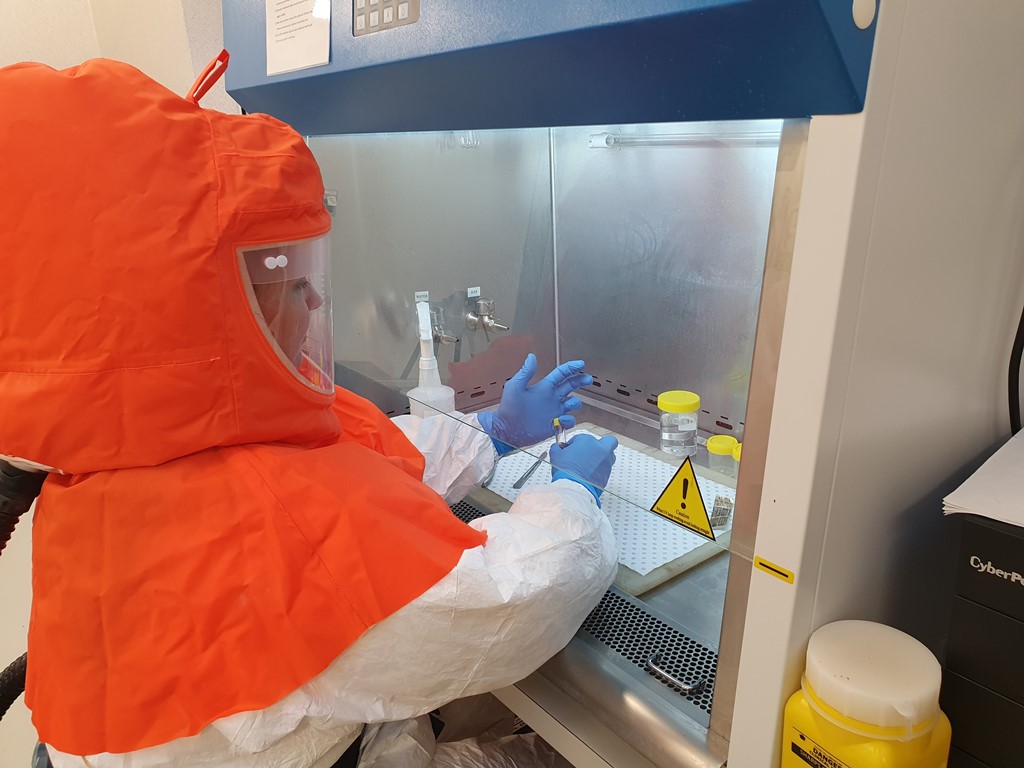Staff try to contain their excitement at biosecurity training


Right: Staff who attended the workshop say they feel much more comfortable and prepared when working in Physical Containment Level 3 facilities.
The staff out at Darwin’s Berrimah Farm Science Precinct were delighted with the new multimillion dollar molecular laboratory that was opened recently.
They were just as pleased with training they undertook recently to take advantage of the lab’s full capabilities, including its Physical Containment Level 3 (PC3) facilities.
The lab has PC3 accreditation – the second highest available – and is the northern most animal health laboratory with premises approved to this level in Australia. It will play a key role in the Northern Territory’s animal and plant biosecurity diagnostic work.
Working effectively in the laboratories demands adherence to rigorous safety procedures.
The 17 staff members who took part in the training – 9 from plant pathology and 8 from the Berrimah Veterinary Laboratories – spent 2 days with Dr Tony Della-Porta to find out more about what’s needed to safely work in a PC3 lab.
The internationally renowned biosecurity, biocontainment and biological safety scientist, Dr Della-Porta is the Managing Director of Biosecurity and Biocontainment International Consultants.
The interactive program concentrated on Australian and New Zealand biosecurity standards (considered the strictest in the world) and covered everything from how to cope with a quarantine breach to respiratory protection, from the operation of biological safety cabinets to the decontamination of rooms.
Dr Della-Porta, who worked for CSIRO for more than 30 years before setting up his specialist consultancy, says: “We covered both animal health and plant diseases for the site.”
He gave many real-life case studies to emphasise the need for safety vigilance.
For instance, Dr Della-Porta detailed the sabia virus incident at Yale University in America in 1994.
“A visiting researcher became infected following a centrifuge accident and nearly died,” he says.
Other case studies included:
- A Singaporean PhD student becoming infected when his stock of West Nile virus was contaminated with SARS-CoV in 2004
- A senior researcher in Taiwan becoming infected when he cleaned up a spill incorrectly
- A medical photographer becoming infected with smallpox at the University of Birmingham in Britain.
There were also talks on tuberculosis safety, incident reporting, risk assessment, the importance of good management, continued staff training, and record keeping.
Veterinary pathologist Dr Ayrial Foster says: “It was brilliant to see the new PC3 lab because we will use it quite a lot for diagnostics, for example Hendra virus.”
Dr Foster says the course was very interactive and Dr Della-Porta was “brilliant and insightful”.
“The training came at a perfect time to give us the insight that we need going forward,” she says. “We’re increasing our capability year by year.”
Dr Foster’s colleague, technical officer Ellie Hills says the training was realistic and relevant to the team’s work.
“My first experience with PC3 was working with samples from Papua New Guinea and their cattle and due to the samples being from overseas we have to treat them with the highest level of biosecurity.”
Ms Hills says the program made participants fully aware of all the biosecurity requirements for the new multimillion dollar molecular laboratory.
